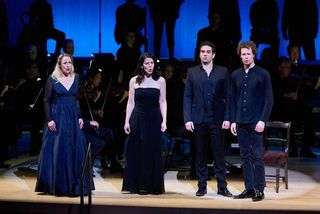|
Back
When a performance becomes an experience Toronto
Roy Thomson Hall
01/21/2016 - & January 22, 23, 2016
Wolfgang Amadeus Mozart: Larghetto from Clarinet Quintet in A Major, K. 581 – Requiem, K. 626 (compl. by Robert D. Levin)
Lydia Teuscher (soprano), Allyson McHardy (mezzo-soprano), Frédéric Antoun (tenor), Philippe Sly (bass-baritone), Joaquin Valdepenas (clarinet)
Amadeus Choir & Elmer Iseler Singers, Lydia Adams (artistic director), The Toronto Symphony Orchestra, Bernard Labadie (conductor)
Joel Ivany (stage director), Kevin Lamotte (lighting designer)

L. Teuscher, A. McHardy, F. Antoun, P. Sly (© Malcolm Cook)
This was certainly an Event (note the capital E), a much-performed piece given a treatment that is both innovative and insightful, played to a full house (with a diverse and very attentive audience) preceded by a mob scene at the box office for any remaining tickets. In short, an orchestra management’s dream come true!
What we all came out for was a staged performance of Mozart’s Requiem under the direction of Joel Ivany, founding director of the enterprising Against the Grain Theatre Company, with a vital contribution from lighting designer Kevin Lamotte.
The intermissionless concert opened with a limpid performance of the larghetto from Mozart’s Clarinet Quintet (performed by the orchestra’s principal clarinetist, Joaquin Valdepeñas, and violinists Jonathan Crow and Mark Skazinetsky, violist Teng Li, and cellist Joseph Johnson) in a pool of light at the front of the platform. While they played, the four soloists advanced slowly along the aisles, followed by the 40 choristers; the orchestral players (about 45 in number) and conductor entered unobtrusively from the wings.
Without giving a lengthy description of the staging, what unfolded was an implied drama with four central mourners (the requiem’s soloists) interacting with a deeply concerned larger group (the choir) all engaged in what appears to be a large scale commemorative event. Joel Ivany’s notes mention Elisabeth Kübler-Ross’s work on grieving; the stage action does not take us through any defined ceremony or procedure, but there are various eruptions of emotion, some times by an individual, other times by a group.
Lighting was an important component of the event, with blue lighting very dark at first and gradually brightening as the event progressed. There was a pool of light for each of the four principals which they mostly ignored. It was as if strict procedures had been planned but emotions of the moment over-rode them. All this served to keep the audience slightly off-guard and rather oddly more a participant in the event than merely onlookers.
The choir sang “off book” so they could participate in the staging. They were loosely arrayed along the back of the platform (with some moving to the front at times) and the result was a less unified sound than we normally expect in a concert. More rehearsal might have helped, but the lack of ideal unison helped give the performance a delicate (even fragile) soft edge. While a recording of the performance would be deemed sub-par, it became less a performance than a total communal experience.
The four soloists were all terrific. Making her local debut was German soprano Lydia Teuscher whose voice is absolutely ideal for the role. Philippe Sly sounds even better every time he appears, while Allyson McHardy and Frédéric Antoun each contributed vocal and dramatic focus.
A version of the Requiem not familiar to everyone was used, that of Robert D. Levin, published in 1993. As is well-known, Mozart died before completing the work and his pupil Franz Xavier Süssmayr composed a “completion” that was really more of tidy wrap-up. Levin’s extends uncompleted passages in a seamless and convincing Mozartian way.
Another innovation revealed at this performance: Roy Thomson Hall is circular in shape which results in upper level seating on a curve, amphitheatre-style. A camera has been set up focused on the conductor with a projection from screens placed toward the rear of the orchestra level. Not everyone can see these screens but some seats toward the sides of the curve (such as the one I was assigned) have a view of one of the screens. I suppose it is to add another interesting element to the concert experience for a portion of the audience. I didn’t pay much attention to it (after all, this was a concert staged as a drama). We will see to what extent it will be of interest to some and a distraction for others.
It was wonderful to have Bernard Labadie back in the city, especially considering he has been forced into an 18-month hiatus due to severe illness (stage 4 lymphoma) and a harrowing (and ongoing) recovery. One result is that he conducts while seated, and has stopped using the baton. His special sensitive way with Mozart is happily still in evidence. He is one of our national treasures and we look forward to his return next season when he conducts Die Zauberflöte for the Canadian Opera Company.
Michael Johnson
|